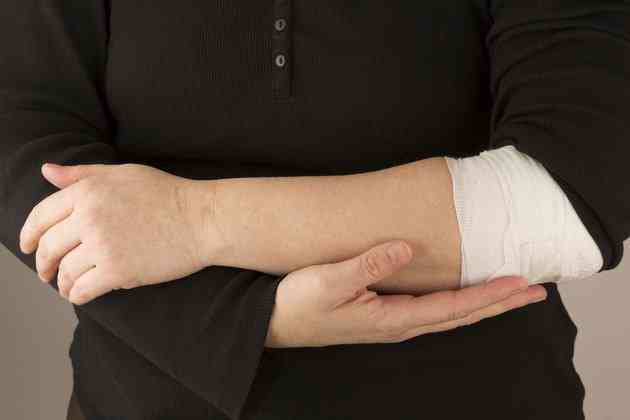Forearm & Wrist Pain From Playing Tennis

Your style of play, how you hit your forehand and backhand or the type of racket you use can all be reasons you experience pain in your forearm and wrist after you play tennis. Treating the pain and preventing further injury requires a plan to first alleviate the pain with ice and rest and then perform strengthening and flexibility exercises. If you still experience pain after two to three weeks of at-home treatment, seek the advice of your health care provider.
 Woman holding her wrist after playing game of tennis. (Image: George Doyle/Stockbyte/Getty Images)
Woman holding her wrist after playing game of tennis. (Image: George Doyle/Stockbyte/Getty Images)Affected Muscles
Every time you strike the ball a group of arm muscles are engaged to control the movement of your forearm, wrist and hand. The main muscles originate near your elbow and include the wrist extensors, wrist flexors, supinators, pronators and brachioradialis. The extensors are a group of eight muscles, which extend your wrist. A group of six muscles, the flexors, work to flex your wrists. The pronators work to rotate your forearm from a palms-up to a palms-down position. The supinators do the opposite -- rotate your forearm from a palms-down to a palms-up position. The brachioradialis flexes your forearm at your elbow.
Possible Causes
Overuse, poor stroke mechanics and the wrong equipment are the main reasons tennis players experience pain in their forearm and wrist. Players who use extreme grips, such as the Western forehand, and hit with excessive spin are susceptible to injury. These players place their forearm and wrist in a position that puts undue stress and strain on the muscles and tendons. This can lead to small tears, inflammation and tendonitis, which can cause the pain, according to Todd S. Ellenbecker, USTA physical therapist. With poor technique, it's even possible for players who play with a two-handed backhand to develop tendonitis in their non-dominant wrist. Playing with a grip that is too small for your hand or a light-weight racket can also lead to forearm stress and strain. Instead of the racket frame, your arm absorbs the shock generated from the impact.
Know the Signs and Symptoms
A radiating pain running down your forearm to your wrist and a weak grip are classic symptoms of tendonitis. In some cases you may notice a slight swelling of your wrist and redness around the joint. Actions such as shaking hands, lifting a heavy object or turning a key can be very painful.
Strengthen the Muscles
Once the pain has subsided and is manageable, it's important to strengthen the muscles of your forearm and the muscles that help stabilize your wrist. Use a 3- to 5-pound dumbbell and perform isolation wrist flexion and extension exercises as well as forearm pronation exercises. These exercises can also be performed with an inexpensive resistance band. To improve your grip strength, squeeze an old, squishy tennis ball. Perform two to three sets of 10 reps with each exercise and work both arms.
Stretching Exercises
To help prevent forearm and wrist injury, increase the flexibility in your muscles with wrist flexor and extensor stretches. To perform a wrist extensor stretch, extend your arm with your palm down. Bend your wrist, point your fingers down and pull your fingers toward you with your other hand to stretch the muscles on the top of your forearm and wrist. For a wrist flexor stretch, turn your arm over so your palm faces up. Pull your fingers down with your other hand to stretch the muscles underneath your forearm. Stretch both arms and hold each stretch for 20 to 30 seconds. Only stretch your muscles when they are warm -- after you play.




